Planning a trip to Vietnam and wondering about Bai Dinh Pagoda’s Tam The Hall? SIXT.VN is here to guide you! This magnificent hall is a key highlight of the pagoda, offering a glimpse into Vietnamese Buddhist art and spirituality. With SIXT.VN, your visit to Bai Dinh Pagoda will be smooth and unforgettable. Discover the architectural splendor, cultural significance, and spiritual essence of Tam The Hall.
1. What is Tam The Hall and Why is it Important at Bai Dinh Pagoda?
Tam The Hall, also known as the Three Worlds Hall, is a central structure within Bai Dinh Pagoda, holding immense spiritual significance. It houses statues representing the past, present, and future Buddhas, symbolizing the eternal nature of Buddhism.
The importance of Tam The Hall at Bai Dinh Pagoda lies in:
- Spiritual Center: It’s a place of deep reverence where visitors come to pray and reflect on the Buddhist teachings.
- Artistic Grandeur: The hall showcases exquisite craftsmanship and intricate details, reflecting traditional Vietnamese architectural styles.
- Cultural Significance: It represents the profound influence of Buddhism in Vietnamese culture and the importance of spiritual beliefs in daily life.
- Symbolic Representation: The statues of the Three Worlds Buddhas embody the concept of time and the interconnectedness of all beings across different realms.
- Pilgrimage Destination: Bai Dinh Pagoda, with Tam The Hall as its centerpiece, attracts pilgrims from all over Vietnam and beyond, seeking blessings and spiritual enlightenment.
According to the Vietnam National Administration of Tourism, Bai Dinh Pagoda is one of the most visited religious sites in Vietnam, attracting millions of tourists and pilgrims each year. Tam The Hall is a key feature of this attraction, drawing visitors with its spiritual and cultural significance.
2. What Architectural Style Does Tam The Hall Follow?
Tam The Hall at Bai Dinh Pagoda embodies the grandeur of traditional Vietnamese Buddhist architecture. Its design reflects meticulous attention to detail, harmonious proportions, and symbolic elements deeply rooted in Vietnamese culture.
Key architectural features of Tam The Hall include:
- Impressive Scale: The hall is vast, creating a sense of awe and reverence.
- Curved Roofs: The multi-tiered roofs with gracefully curved edges are a signature element of Vietnamese temple architecture, resembling the tail of a phoenix.
- Intricate Carvings: The wooden structures are adorned with elaborate carvings depicting dragons, phoenixes, lotus flowers, and other auspicious symbols.
- Red Lacquered Columns: Massive, red-lacquered wooden columns support the roof, adding to the hall’s imposing presence.
- Harmonious Layout: The layout follows traditional principles of Feng Shui, creating a balanced and harmonious space that promotes peace and contemplation.
- Elevated Platform: The hall is built on an elevated platform, symbolizing its sacredness and separating it from the mundane world.
- Open Courtyard: An open courtyard in front of the hall allows natural light to illuminate the space and provides a gathering place for visitors.
These architectural elements combine to create a space that is both visually stunning and spiritually uplifting, offering visitors a profound experience of Vietnamese Buddhist culture.
3. What Statues are Housed Inside Tam The Hall?
Inside Tam The Hall, you’ll find magnificent statues representing the Three Worlds Buddhas, each embodying a different aspect of time and existence.
The Three Worlds Buddhas and their significance:
- Past Buddha (Kasyapa Buddha): Represents the wisdom and teachings of the past, symbolizing the foundation upon which the present is built.
- Present Buddha (Sakyamuni Buddha): Represents the current era and the teachings of the historical Buddha, guiding beings towards enlightenment in the present moment.
- Future Buddha (Maitreya Buddha): Represents the hope for the future and the promise of a world filled with peace and compassion.
These statues are typically made of bronze or wood and are often gilded with gold, enhancing their splendor and spiritual significance. They are positioned in the center of the hall, commanding respect and reverence from visitors.
4. What is the Significance of the Three Worlds Buddhas?
The Three Worlds Buddhas in Tam The Hall hold profound significance in Buddhist philosophy, representing the interconnectedness of time and the cyclical nature of existence.
The significance of each Buddha:
- Kasyapa Buddha (Past): Highlights the importance of learning from history and the wisdom of past generations.
- Sakyamuni Buddha (Present): Emphasizes the need to practice mindfulness and compassion in the present moment to attain enlightenment.
- Maitreya Buddha (Future): Inspires hope and encourages believers to strive for a better future through ethical conduct and spiritual development.
Together, the Three Worlds Buddhas symbolize the continuity of Buddhist teachings across time and the potential for all beings to achieve enlightenment, regardless of their past, present, or future circumstances.
5. How Does Tam The Hall Reflect Vietnamese Buddhist Beliefs?
Tam The Hall beautifully reflects core Vietnamese Buddhist beliefs through its architecture, iconography, and spiritual atmosphere.
How Tam The Hall embodies Vietnamese Buddhist beliefs:
- Reverence for the Buddhas: The prominent placement and exquisite craftsmanship of the Buddha statues demonstrate the deep respect for the enlightened beings in Vietnamese Buddhism.
- Emphasis on Karma and Rebirth: The concept of the Three Worlds reflects the cyclical nature of existence and the belief in karma, where actions in the past influence the present and future.
- Importance of Ancestral Veneration: Vietnamese Buddhism often incorporates elements of ancestor worship, and Tam The Hall serves as a place to connect with past generations and seek their blessings.
- Syncretism with Local Beliefs: The pagoda’s design and decorations may incorporate local folk beliefs and deities, reflecting the syncretic nature of Vietnamese Buddhism.
- Focus on Compassion and Enlightenment: The presence of the Buddhas inspires visitors to cultivate compassion, seek wisdom, and strive for enlightenment, key tenets of Vietnamese Buddhism.
Through these elements, Tam The Hall provides a tangible representation of the spiritual values and beliefs that are central to Vietnamese Buddhist culture.
6. What Are Some Must-See Features Inside Tam The Hall?
When visiting Tam The Hall, be sure to admire these remarkable features:
- The Three Worlds Buddha Statues: Marvel at the size, detail, and golden splendor of the Kasyapa, Sakyamuni, and Maitreya Buddha statues.
- Intricate Wood Carvings: Examine the elaborate carvings on the columns, beams, and altars, depicting dragons, phoenixes, and other auspicious symbols.
- Ornate Altars: Observe the meticulously decorated altars adorned with offerings of flowers, fruits, and incense.
- Lacquered Panels: Admire the colorful lacquered panels depicting scenes from Buddhist legends and teachings.
- Ceiling Decorations: Look up to see the intricate patterns and designs on the ceiling, often featuring lotus flowers and other symbolic motifs.
- Incense Offerings: Witness the fragrant smoke rising from incense offerings, creating a serene and spiritual atmosphere.
- Overall Grandeur: Take in the overall grandeur of the hall, appreciating the harmonious proportions and the sense of peace and reverence it inspires.
These features offer a glimpse into the artistic skill and spiritual devotion that went into creating this magnificent space.
7. What is the Best Time to Visit Tam The Hall to Avoid Crowds?
To avoid the crowds and fully appreciate the serenity of Tam The Hall, plan your visit during off-peak times.
Best times to visit:
- Early Morning (7:00 AM – 9:00 AM): Arrive as the pagoda opens to experience the peaceful atmosphere before the tour groups arrive.
- Late Afternoon (3:00 PM – 5:00 PM): Visit in the late afternoon after the midday heat and before the pagoda closes.
- Weekdays (Tuesday – Friday): Weekdays tend to be less crowded than weekends, offering a more relaxed experience.
- Avoid Festivals and Holidays: During major Buddhist festivals and Vietnamese holidays, Bai Dinh Pagoda can become extremely crowded.
By visiting during these quieter times, you’ll have a better opportunity to explore Tam The Hall at your own pace and fully immerse yourself in its spiritual ambiance.
8. Are There Any Specific Customs to Observe When Visiting Tam The Hall?
When visiting Tam The Hall, it’s important to observe certain customs to show respect for the sacred space and the Buddhist faith.
Key customs to follow:
- Dress Modestly: Wear clothing that covers your shoulders and knees. Avoid revealing or overly casual attire.
- Remove Shoes and Hats: Take off your shoes and hat before entering the hall.
- Speak Quietly: Maintain a respectful tone and avoid loud conversations or disruptive behavior.
- Do Not Point: Refrain from pointing at the statues or other sacred objects.
- Avoid Touching: Do not touch the statues, altars, or other religious artifacts.
- Offer Incense Properly: If you wish to offer incense, follow the instructions of the temple staff and do so with reverence.
- Maintain a Respectful Demeanor: Be mindful of your actions and maintain a respectful attitude throughout your visit.
By observing these customs, you’ll demonstrate your respect for the local culture and contribute to the peaceful atmosphere of Tam The Hall.
9. What Other Attractions Are Near Tam The Hall at Bai Dinh Pagoda?
Bai Dinh Pagoda is a vast complex with many other attractions to explore beyond Tam The Hall.
Other attractions to visit:
- Phap Chu Hall: Another main hall housing a giant bronze statue of the Buddha.
- Quan Am Temple: Dedicated to the Bodhisattva of Compassion, Avalokitesvara.
- Bao Thap (Stupa): A towering pagoda offering panoramic views of the surrounding landscape.
- Bell Tower: Home to a massive bronze bell weighing 36 tons.
- Arhat Corridor: A long corridor lined with 500 intricately carved statues of arhats.
- Jade Well: A sacred well believed to have healing properties.
- Landscape Gardens: Beautifully landscaped gardens with Bodhi trees, lotus ponds, and stone bridges.
Exploring these other attractions will give you a more complete understanding of the scale and grandeur of Bai Dinh Pagoda.
10. How Can SIXT.VN Help Me Plan My Trip to Bai Dinh Pagoda?
Planning a trip to Bai Dinh Pagoda can be overwhelming, but SIXT.VN is here to make it easy and stress-free.
How SIXT.VN can assist you:
- Transportation: SIXT.VN provides reliable and comfortable airport transfer services to and from Hanoi, ensuring a smooth arrival and departure.
- Accommodation: We offer a wide range of hotel options in Ninh Binh and Hanoi, catering to different budgets and preferences.
- Tours: SIXT.VN organizes guided tours to Bai Dinh Pagoda, allowing you to explore the site with knowledgeable local experts.
- Tickets: We can assist you in purchasing tickets for electric car rides within the pagoda complex, saving you time and hassle.
- Custom Itineraries: Our travel experts can create custom itineraries tailored to your interests and schedule, ensuring you make the most of your trip.
- 24/7 Support: SIXT.VN provides 24/7 customer support, so you can rest assured that help is always available if you need it.
Let SIXT.VN take care of the details, so you can focus on experiencing the beauty and spirituality of Bai Dinh Pagoda and Tam The Hall.
11. What Are the Entrance Fees and Opening Hours for Bai Dinh Pagoda?
Planning your visit to Bai Dinh Pagoda requires knowing the entrance fees and opening hours to ensure a smooth experience.
Here’s a breakdown:
| Information | Details |
|---|---|
| Entrance Fee | Admission to Bai Dinh Pagoda is free. However, there are fees for optional services such as the electric car to transport visitors around the complex and access to the Bao Thap (Treasure Tower). |
| Electric Car Fee | The electric car service, which takes you from the entrance to the main temple area, typically costs around 30,000 VND (approximately $1.30 USD) per person, per trip. This can save a significant amount of walking, especially during hot weather. |
| Bao Thap Access | Access to the Bao Thap, which offers panoramic views of the area, may require a separate ticket. The fee is nominal, usually around 50,000 VND (approximately $2.20 USD) per person. |
| Opening Hours | Bai Dinh Pagoda is generally open from 7:00 AM to 6:00 PM daily. It’s best to arrive early to avoid crowds, especially on weekends and holidays. Note that hours may vary slightly depending on the season and any special events taking place at the pagoda. It’s advisable to check in advance. |
12. What Local Foods Should I Try Near Bai Dinh Pagoda?
Exploring the local cuisine near Bai Dinh Pagoda is a must for any traveler wanting to immerse themselves in the culture. Ninh Binh province offers several unique dishes that are worth trying.
Here are some local foods you should sample:
- Com Chay (Crispy Rice Crust): This is perhaps the most famous dish in Ninh Binh. It consists of crispy, golden-brown rice crusts that are usually served with a savory sauce made from meat (often goat), mushrooms, and vegetables. It’s a delightful combination of textures and flavors.
- De Nui (Mountain Goat): Goat meat is a specialty in Ninh Binh, thanks to the region’s limestone mountains, which are perfect for raising goats. The goat meat is prepared in various ways, such as grilled, steamed, stir-fried, or used in curries. It’s known for being lean and flavorful.
- Goi Ca Nhech (Raw Nhech Fish Salad): This dish is made from the raw meat of the Nhech fish, a type of eel found in the local rivers. The fish is carefully prepared and mixed with roasted rice powder, herbs, and spices, then served with a special dipping sauce. It’s a unique and adventurous culinary experience.
- Banh Da Ca Ro (Fish and Rice Cake Soup): This flavorful soup features a rich broth made from fish bones, served with fresh rice noodles, fried fish, and crispy rice cakes. It’s a hearty and satisfying meal that’s perfect for any time of day.
- Nem Chua Ran (Fried Fermented Pork Roll): These are small, tangy pork rolls that have been fermented and then deep-fried until crispy. They are often served as an appetizer with chili sauce or sweet and sour sauce.
- Che (Sweet Dessert Soup): There are many variations of Che in Vietnam, and Ninh Binh is no exception. Che can include ingredients like beans, sticky rice, tapioca, and fruits, all served in a sweet coconut milk broth. It’s a refreshing way to end your meal.
Make sure to visit local restaurants and eateries to get an authentic taste of Ninh Binh’s culinary delights. Don’t hesitate to ask locals for their recommendations!
13. What Are Some Day Trip Options From Bai Dinh Pagoda?
Bai Dinh Pagoda is located in Ninh Binh province, which is renowned for its stunning natural landscapes and historical sites. This makes it an ideal base for several exciting day trips.
Here are some options for day trips from Bai Dinh Pagoda:
- Trang An Scenic Landscape Complex: A UNESCO World Heritage site, Trang An features a breathtaking network of limestone karst mountains, caves, and rivers. You can take a boat tour through the caves, visit ancient temples, and enjoy the serene natural beauty. The boat tours typically last 2-3 hours.
- Tam Coc (Three Caves): Often referred to as “Halong Bay on Land,” Tam Coc offers a similar experience to Trang An with boat tours through picturesque caves and rice paddies. The Ngo Dong River winds through the landscape, providing stunning views.
- Mua Cave (Hang Mua): Known for its panoramic views of Tam Coc, Mua Cave requires climbing 500 steps to reach the top. From there, you can see the winding river, rice fields, and limestone karsts stretching out before you. It’s a photographer’s dream.
- Hoa Lu Ancient Capital: Visit the ancient capital of Vietnam from the 10th and 11th centuries. Explore the temples dedicated to Emperor Dinh Tien Hoang and Emperor Le Dai Hanh, and learn about Vietnam’s history.
- Van Long Nature Reserve: The largest wetland reserve in the Red River Delta, Van Long is home to diverse flora and fauna, including the Delacour’s langur, an endangered primate. Take a boat tour to observe the wildlife and enjoy the tranquility of the wetlands.
- Phat Diem Cathedral: A unique blend of Vietnamese and European architectural styles, Phat Diem Cathedral is one of the most beautiful churches in Vietnam. It was built in the late 19th century and features intricate stone carvings and traditional Vietnamese roofing.
- Cuc Phuong National Park: Vietnam’s oldest national park, Cuc Phuong is a haven for nature lovers. It features lush forests, diverse wildlife, and hiking trails. You can visit the Endangered Primate Rescue Center and explore the park’s caves and waterfalls.
These day trips offer a perfect blend of cultural, historical, and natural attractions, ensuring a memorable experience in Ninh Binh province.
14. What Type of Clothing Should I Wear When Visiting Tam The Hall?
Choosing the right attire for visiting Tam The Hall at Bai Dinh Pagoda is crucial for showing respect and ensuring comfort.
Here’s what you should wear:
- Modest Clothing: Opt for modest clothing that covers your shoulders and knees. This shows respect for the religious site and the local culture. Avoid wearing revealing clothing such as tank tops, shorts, or skirts above the knee.
- Loose and Comfortable Fabrics: Given the warm and humid climate in Ninh Binh, choose lightweight, breathable fabrics like cotton or linen. Loose-fitting clothing will help you stay comfortable as you explore the pagoda complex.
- Covered Shoulders: Ensure your shoulders are covered. You can wear a t-shirt, blouse, or a light shawl or scarf.
- Long Pants or Skirts: Wear long pants, trousers, or a long skirt that covers your knees. Avoid shorts or short skirts.
- Comfortable Shoes: You’ll be doing a lot of walking, so wear comfortable shoes. Sandals, sneakers, or walking shoes are good choices. Avoid high heels, as they may be difficult to walk in on uneven surfaces.
- Hat or Umbrella: Protect yourself from the sun with a hat or umbrella, especially during the hotter months.
- Sunglasses: Sunglasses can also help protect your eyes from the bright sunlight.
- Rain Gear: If you’re visiting during the rainy season (May to October), bring a raincoat or umbrella.
- Avoid Distracting Accessories: It’s best to avoid wearing flashy or distracting accessories that could draw unwanted attention.
By dressing modestly and comfortably, you’ll be well-prepared to explore Tam The Hall and Bai Dinh Pagoda while showing respect for the local customs.
15. What Kind of Photography is Allowed at Tam The Hall?
Understanding the photography guidelines at Tam The Hall is essential for capturing memorable moments while respecting the sacred environment.
Here’s what you need to know:
- General Photography: Photography is generally allowed in the outdoor areas of Bai Dinh Pagoda, including the courtyards, gardens, and exterior of Tam The Hall. Feel free to take photos of the architecture, landscapes, and general surroundings.
- Inside Tam The Hall: Inside Tam The Hall, photography may be restricted or prohibited. Many temples and religious sites in Vietnam do not allow photography inside the main prayer halls to maintain the sanctity of the space and avoid disturbing worshippers.
- Flash Photography: Flash photography is usually not allowed inside Tam The Hall or other indoor areas. The bright flash can be disruptive and may damage delicate artifacts.
- Tripods and Professional Equipment: Using tripods or professional photography equipment may require prior permission from the pagoda management. It’s best to check in advance if you plan to use such equipment.
- Respectful Conduct: Always be respectful when taking photos. Avoid blocking pathways, disrupting worshippers, or intruding on private ceremonies.
- Signage: Look for signs indicating whether photography is allowed in specific areas. If you’re unsure, it’s always best to ask a temple staff member.
- Alternative Options: If photography is not allowed inside Tam The Hall, you can still capture the beauty of the interior with your eyes and remember the experience. Consider purchasing postcards or souvenirs that feature images of the hall.
- Drones: Drone photography is generally restricted at Bai Dinh Pagoda without prior permission. Check with the local authorities or pagoda management for regulations regarding drone usage.
By following these guidelines, you can capture beautiful memories of your visit to Tam The Hall while showing respect for the sacred environment and local customs.
16. How Does SIXT.VN Ensure a Safe and Reliable Trip to Bai Dinh Pagoda?
SIXT.VN prioritizes your safety and comfort, ensuring a reliable and worry-free trip to Bai Dinh Pagoda.
Here’s how SIXT.VN ensures your safety:
- Professional and Experienced Drivers: SIXT.VN hires professional and experienced drivers who are familiar with the local roads and traffic conditions. They are trained to provide safe and courteous transportation.
- Well-Maintained Vehicles: SIXT.VN maintains a fleet of well-maintained vehicles that undergo regular safety checks. The vehicles are clean, comfortable, and equipped with air conditioning.
- Airport Transfer Services: SIXT.VN offers reliable airport transfer services, ensuring you arrive at your destination safely and on time. The drivers will meet you at the airport and assist you with your luggage.
- Licensed Tour Guides: If you book a guided tour with SIXT.VN, you’ll be accompanied by licensed tour guides who are knowledgeable about the history, culture, and customs of Bai Dinh Pagoda.
- 24/7 Customer Support: SIXT.VN provides 24/7 customer support, so you can reach out for assistance at any time. Whether you have a question, need to make a change to your booking, or encounter an issue during your trip, the support team is available to help.
- Travel Insurance: SIXT.VN recommends purchasing travel insurance to protect yourself against unexpected events such as illness, injury, or trip cancellations.
- Emergency Assistance: SIXT.VN has procedures in place to handle emergencies and provide assistance to travelers in need.
- Trusted Partners: SIXT.VN works with trusted partners, including hotels and tour operators, to ensure the quality and reliability of the services provided.
- Adherence to Safety Standards: SIXT.VN adheres to all relevant safety standards and regulations to ensure the well-being of its customers.
With SIXT.VN, you can relax and enjoy your trip to Bai Dinh Pagoda, knowing that your safety and comfort are in good hands.
17. What Is the Best Way to Get to Bai Dinh Pagoda From Hanoi?
Getting to Bai Dinh Pagoda from Hanoi is straightforward, with several transportation options available.
Here are the most common ways to travel:
- Private Car: Hiring a private car is the most convenient and comfortable option. SIXT.VN offers private car services from Hanoi to Bai Dinh Pagoda, with experienced drivers who can take you directly to the site. This option allows you to travel at your own pace and make stops along the way.
- Taxi: Taxis are readily available in Hanoi, but it’s important to negotiate the fare in advance or use a metered taxi to avoid overcharging. The journey to Bai Dinh Pagoda takes approximately 2-3 hours, depending on traffic.
- Bus: Several bus companies operate routes from Hanoi to Ninh Binh. You can catch a bus from one of Hanoi’s main bus stations, such as Giap Bat or My Dinh. From Ninh Binh city, you’ll need to take a taxi or local bus to Bai Dinh Pagoda.
- Train: You can take a train from Hanoi to Ninh Binh city. The train journey takes approximately 2.5-3 hours. From Ninh Binh train station, you’ll need to take a taxi or local bus to Bai Dinh Pagoda.
- Motorbike: If you’re an experienced motorbike rider, you can rent a motorbike in Hanoi and ride to Bai Dinh Pagoda. However, this option is not recommended for inexperienced riders, as the traffic in Vietnam can be challenging.
- Organized Tour: Booking an organized tour from Hanoi is a hassle-free way to visit Bai Dinh Pagoda. SIXT.VN offers guided tours that include transportation, entrance fees, and a knowledgeable tour guide.
The best option for you will depend on your budget, preferences, and travel style. If you’re looking for convenience and comfort, a private car or organized tour is recommended. If you’re on a budget, the bus or train may be a better option.
18. Are There Any Special Events or Festivals Held at Bai Dinh Pagoda?
Bai Dinh Pagoda is a site of significant religious and cultural importance, hosting several special events and festivals throughout the year.
Here are some of the most notable events:
- Bai Dinh Pagoda Festival: The main festival at Bai Dinh Pagoda takes place annually from the 6th day of the first lunar month to the end of the third lunar month. This festival attracts thousands of pilgrims and tourists who come to pay their respects, offer prayers, and participate in cultural activities.
- Buddha’s Birthday (Vesak): Celebrated on the full moon day of the fourth lunar month, Buddha’s Birthday is a major event at Bai Dinh Pagoda. The pagoda is decorated with colorful lanterns and flags, and special ceremonies are held to commemorate the birth, enlightenment, and death of the Buddha.
- Vu Lan Festival (Ghost Festival): Held on the 15th day of the seventh lunar month, Vu Lan Festival is a time to remember and honor ancestors. At Bai Dinh Pagoda, monks lead prayers and ceremonies to help wandering souls find peace.
- Tet (Vietnamese New Year): Tet is the most important holiday in Vietnam, and it is celebrated at Bai Dinh Pagoda with traditional customs and rituals. Many people visit the pagoda during Tet to pray for good luck and prosperity in the new year.
- Other Buddhist Holidays: Bai Dinh Pagoda also observes other important Buddhist holidays, such as Avalokitesvara Bodhisattva’s Day (February 19th of the lunar calendar) and Enlightenment Day (December 8th of the lunar calendar).
Attending one of these special events or festivals can enhance your visit to Bai Dinh Pagoda and provide a deeper understanding of Vietnamese Buddhist culture. However, be prepared for larger crowds during these times.
19. How Can I Book a Tour to Bai Dinh Pagoda With SIXT.VN?
Booking a tour to Bai Dinh Pagoda with SIXT.VN is easy and convenient.
Here are the steps to book your tour:
- Visit the SIXT.VN Website: Go to the SIXT.VN website using your computer or mobile device.
- Search for Bai Dinh Pagoda Tours: Use the search bar to look for tours to Bai Dinh Pagoda or Ninh Binh. You can also browse the “Tours” section of the website.
- Select a Tour: Review the available tours and choose the one that best suits your interests and budget. Consider factors such as the duration of the tour, the attractions included, and the price.
- Check Availability: Check the availability of the tour for your desired travel dates. SIXT.VN will show you the dates and times when the tour is available.
- Provide Your Information: Enter your personal information, such as your name, email address, and phone number. You may also need to provide the names and passport details of all travelers in your group.
- Customize Your Tour (If Applicable): Some tours may offer customization options, such as adding extra activities or meals. If available, customize the tour to your liking.
- Review Your Booking: Double-check all the details of your booking to ensure they are correct. Pay close attention to the tour dates, times, and the number of travelers.
- Make Payment: Choose your preferred payment method and make the payment. SIXT.VN accepts various payment options, such as credit cards, debit cards, and online payment platforms.
- Receive Confirmation: After making the payment, you will receive a confirmation email with all the details of your tour. Be sure to save this email for your reference.
- Contact SIXT.VN if you have questions:
- Address: 260 Cau Giay, Hanoi, Vietnam
- Hotline/Whatsapp: +84 986 244 358
- Website: SIXT.VN
By following these steps, you can easily book your tour to Bai Dinh Pagoda with SIXT.VN and look forward to a memorable travel experience.
20. What Are Some Tips for a Smooth Visit to Bai Dinh Pagoda?
To ensure a smooth and enjoyable visit to Bai Dinh Pagoda, consider these helpful tips:
- Plan Ahead: Research Bai Dinh Pagoda and Ninh Binh province to identify the attractions you want to see and the activities you want to do. Book your transportation, accommodation, and tours in advance, especially during peak season.
- Dress Appropriately: Wear modest clothing that covers your shoulders and knees to show respect for the religious site. Choose lightweight, breathable fabrics to stay comfortable in the warm climate.
- Wear Comfortable Shoes: You’ll be doing a lot of walking, so wear comfortable shoes.
- Bring Sun Protection: Protect yourself from the sun with a hat, sunglasses, and sunscreen.
- Stay Hydrated: Drink plenty of water to stay hydrated, especially during the hotter months.
- Bring Insect Repellent: Mosquitoes and other insects can be a nuisance, so bring insect repellent to protect yourself.
- Learn Some Basic Vietnamese Phrases: Learning a few basic Vietnamese phrases, such as “hello” (xin chào) and “thank you” (cảm ơn), can be helpful and appreciated by locals.
- Bargain Respectfully: If you’re shopping at local markets, bargain respectfully. Start by offering a lower price than the asking price and be prepared to negotiate.
- Be Aware of Scams: Be aware of common tourist scams, such as overcharging for transportation or goods. Use reputable service providers and negotiate prices in advance.
- Respect Local Customs: Respect local customs and traditions. Avoid public displays of affection, and be mindful of your behavior in religious sites.
- Carry Small Change: Carry small change for paying for transportation, snacks, and souvenirs.
- Be Patient: Things may not always go according to plan, so be patient and flexible. Embrace the unexpected and enjoy the journey.
- Have Fun: Most importantly, relax, have fun, and enjoy your visit to Bai Dinh Pagoda and Ninh Binh province.
By following these tips, you can have a smooth, enjoyable and memorable visit to Bai Dinh Pagoda.
Let SIXT.VN be your trusted partner in planning your trip to Bai Dinh Pagoda! We offer a comprehensive range of services, including airport transfers, hotel bookings, guided tours, and custom itineraries. Contact us today to start planning your dream vacation!
Address: 260 Cau Giay, Hanoi, Vietnam
Hotline/Whatsapp: +84 986 244 358
Website: SIXT.VN
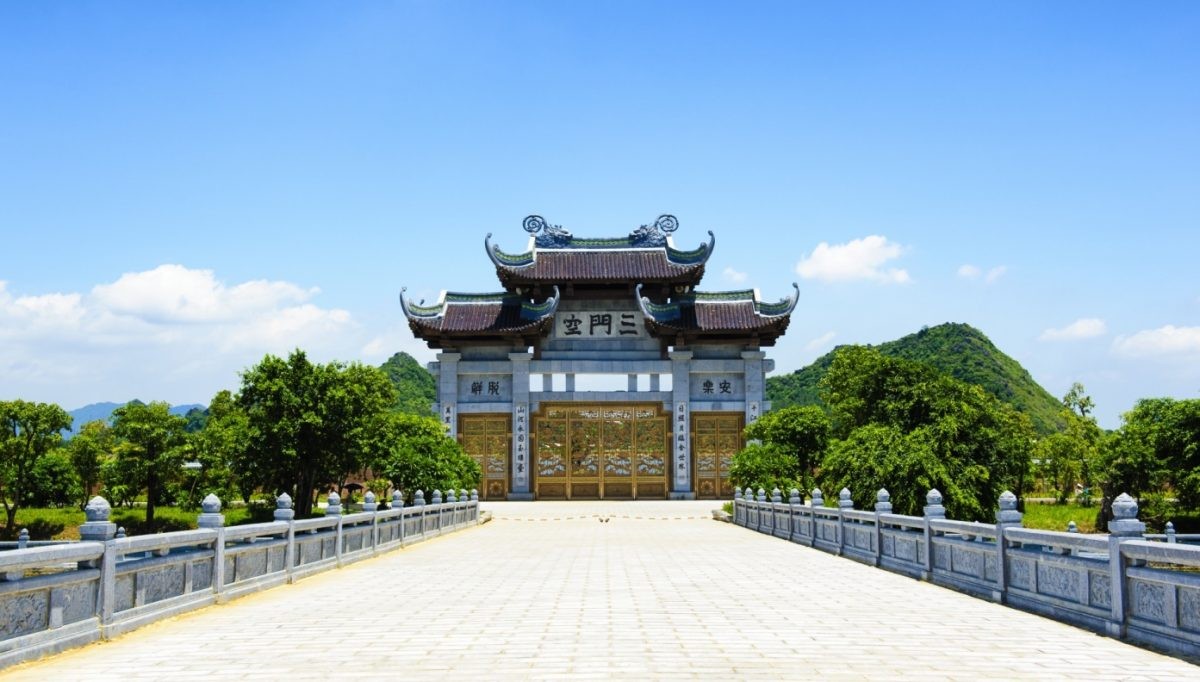 Tam Quan Gate at Bai Dinh Pagoda
Tam Quan Gate at Bai Dinh Pagoda
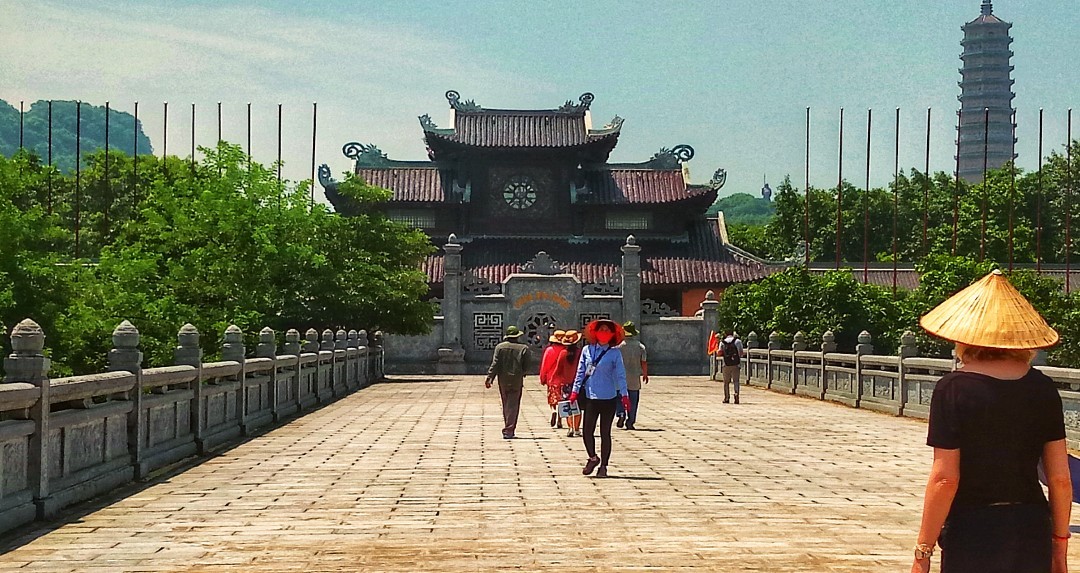 The three-portal entry gate to Bai Dinh Pagoda
The three-portal entry gate to Bai Dinh Pagoda
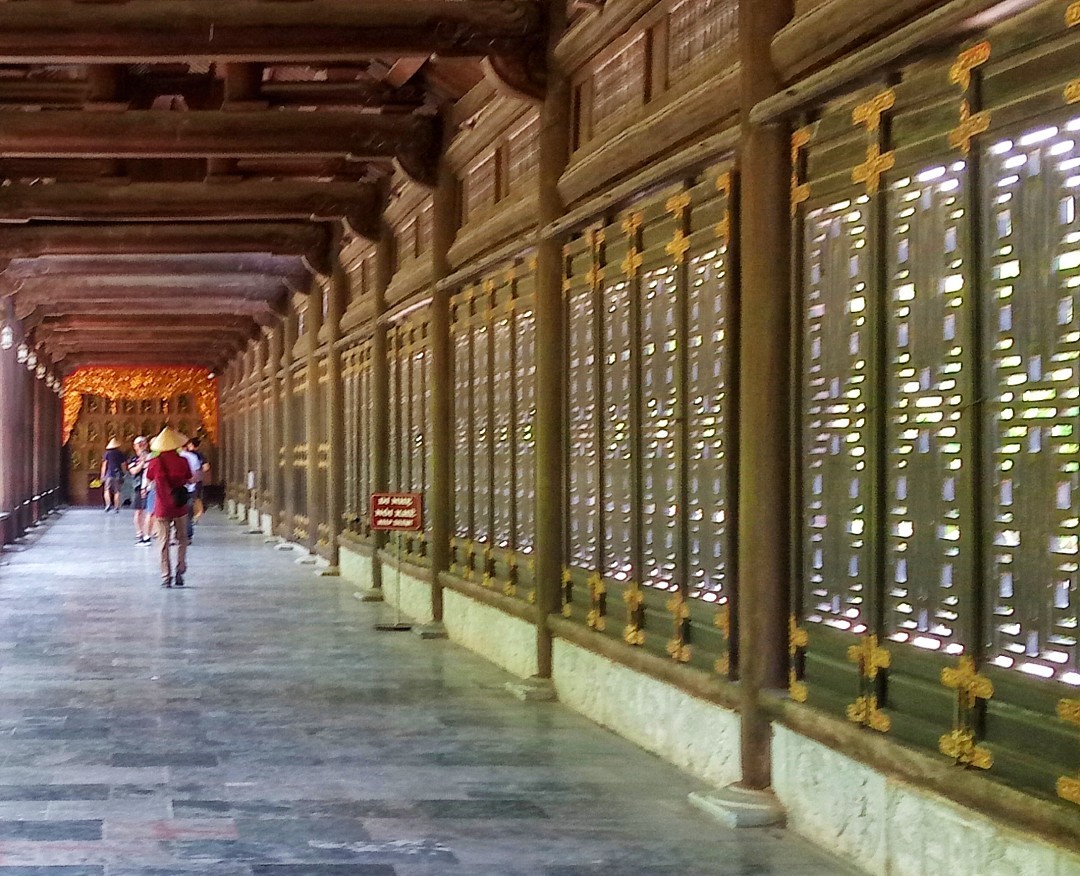 View of the courtyard at Bai Dinh Pagoda
View of the courtyard at Bai Dinh Pagoda
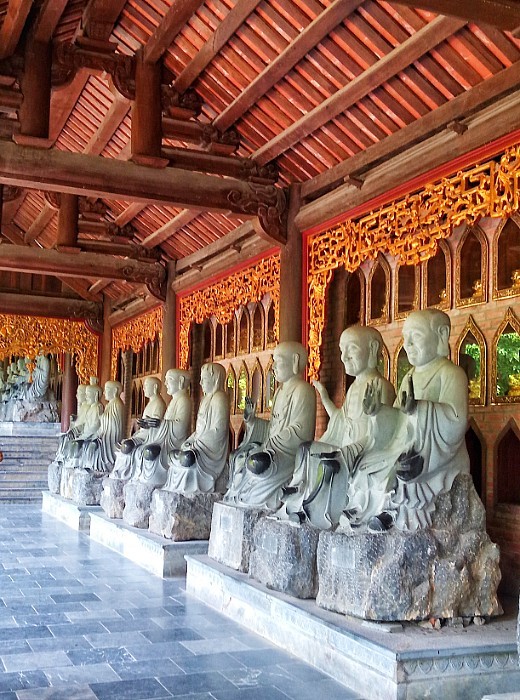 A row of Arhat statues at Bai Dinh Pagoda
A row of Arhat statues at Bai Dinh Pagoda
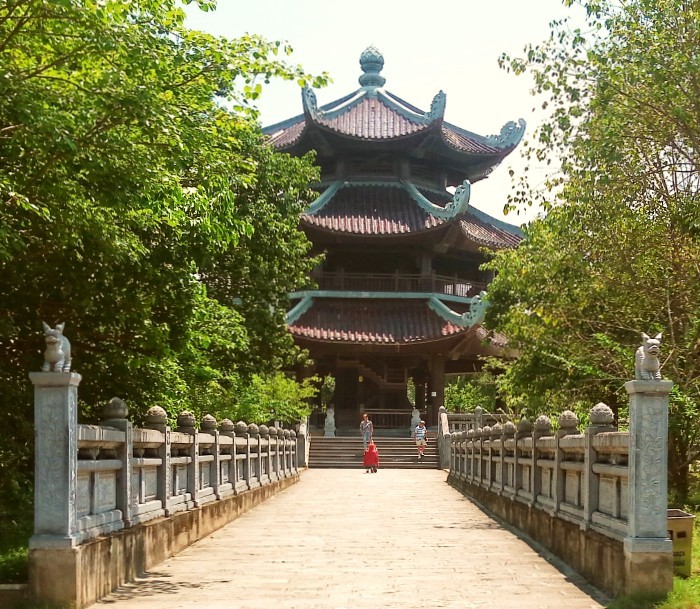 Exterior of the Bell Tower at Bai Dinh Pagoda
Exterior of the Bell Tower at Bai Dinh Pagoda
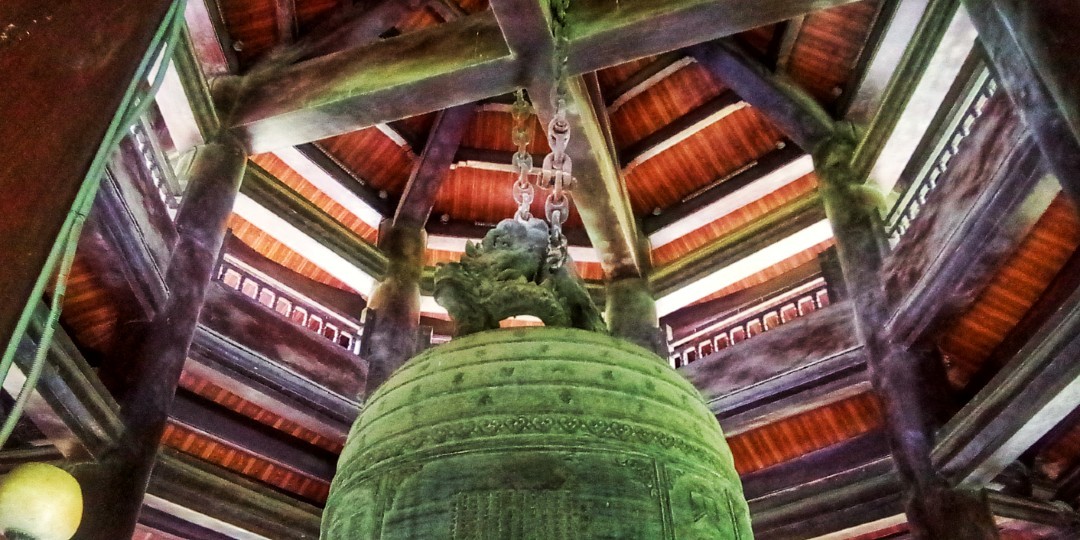 Inside the Bell Tower at Bai Dinh Pagoda
Inside the Bell Tower at Bai Dinh Pagoda
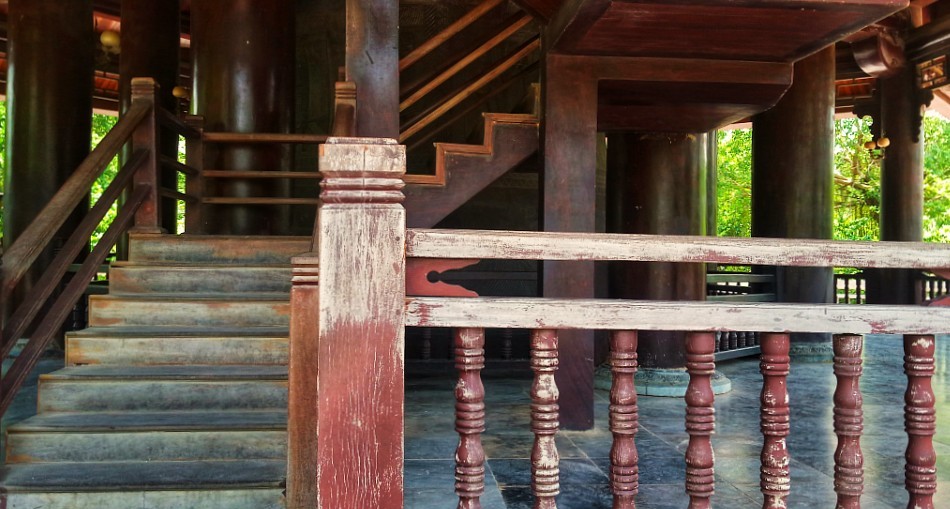 Entrance to the Bell Tower at Bai Dinh Pagoda
Entrance to the Bell Tower at Bai Dinh Pagoda
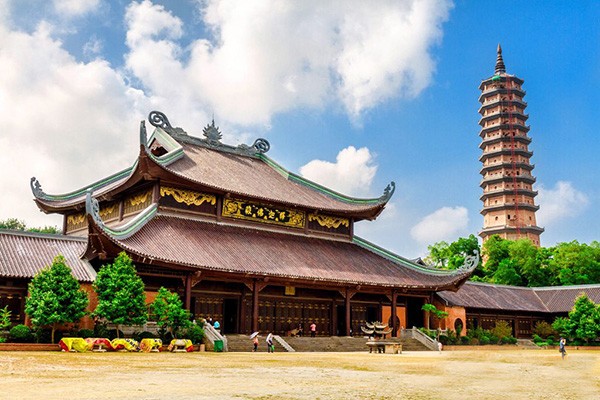 Exterior of Phap Chu Hall at Bai Dinh Pagoda
Exterior of Phap Chu Hall at Bai Dinh Pagoda
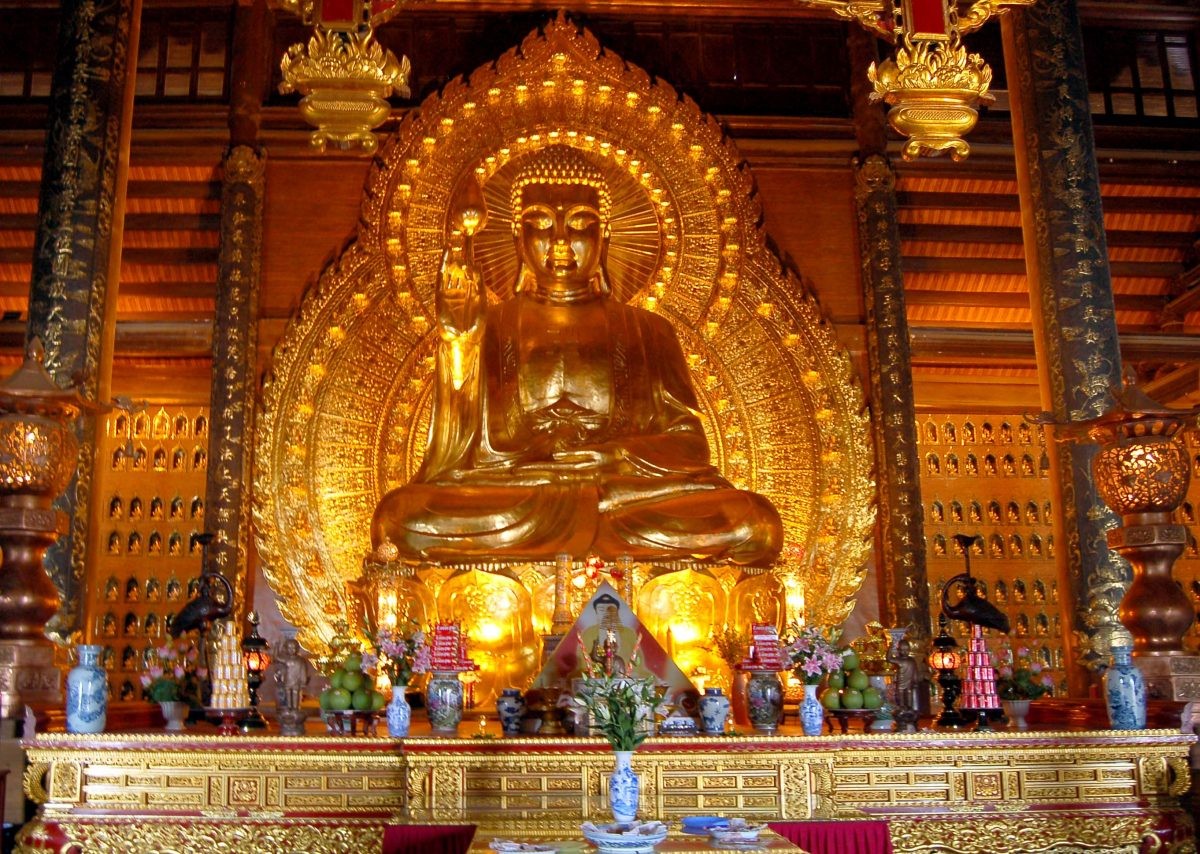 Gautama Buddha statue inside Phap Chu Hall
Gautama Buddha statue inside Phap Chu Hall
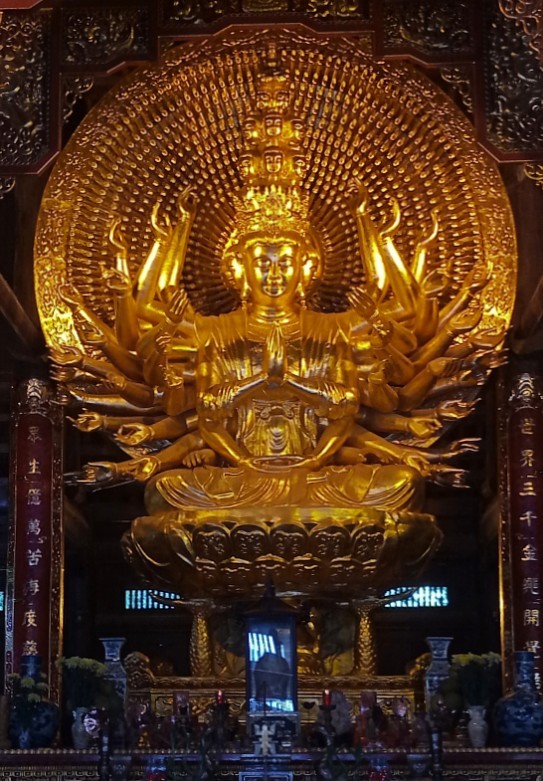 Interior of Bodhisattva Temple at Bai Dinh Pagoda
Interior of Bodhisattva Temple at Bai Dinh Pagoda
FAQ About Tam The Hall at Bai Dinh Pagoda:
Q1: What makes Tam The Hall a significant part of Bai Dinh Pagoda?
Tam The Hall is significant because it houses the statues of the Three Worlds Buddhas, representing the past, present, and future, and is a key spiritual and architectural highlight of the pagoda.
Q2: Can I take photos inside Tam The Hall?
Photography restrictions may apply inside Tam The Hall; it’s best to check with temple staff or look for signage to ensure respectful conduct and avoid disturbing worshippers.
Q3: What should I wear when visiting Tam The Hall?
It’s important to wear modest clothing that covers your shoulders



